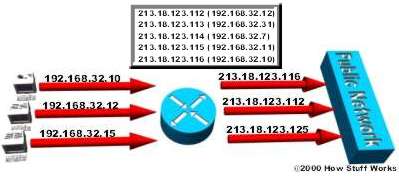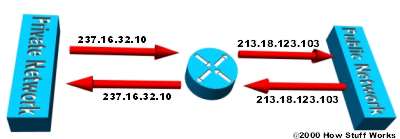Types of NATs
NAT operates by creating bindings between addresses.
Static NAT
Static NAT is a one-to-one mapping between an unregistered IP address and a registered IP address.
Dynamic NAT

More commonly, Dynamic NAT is implemented, where a pool of public IP addresses is shared by an entire private IP subnet. When a private host initiates a connection, a public IP address is selected. The mapping of the computerís non-routable IP address matched to the selected IP address is stored in the NAT Table. As long as the outgoing connection is maintained, the private host can be reached by incoming packets sent to the specified public address. When the binding expires, the address is returned to the pool for reuse.
Overloading

A variation of Dynamic NAT known as Network Address Port Translation (NAPT) maps multiple unregistered IP addresses to a single registered IP address by multiplexing streams differentiated by the TCP/UDP port number.
Overlapping

When Overlapping is employed, the IP addresses used on the internal network are registered IP addresses utilized on another network. To avoid conflict, a NAT Table is built to translate these redundant internal addresses to a unique IP address. Vice versa, when sending packets into the private network, the registered addresses must be translated to an address unique in the network.
Because these schemes can be used interchangeably, NAT can be configured in various ways pending on the restrictions and requirements of the stub domain.
